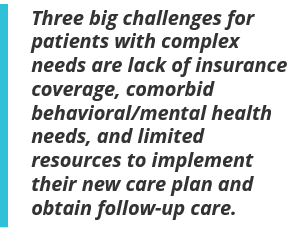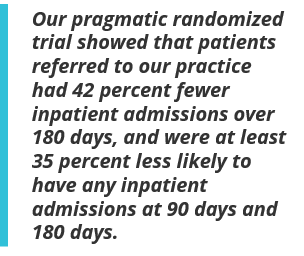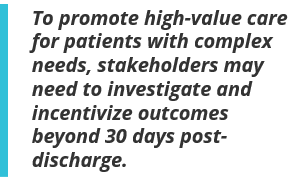Transitional care programs can help address critical gaps in care for people with complex needs moving between locations of care, such as from hospital to home. Yet, transitional care programs vary widely, both in terms of what services they provide, and whether services are delivered before hospital discharge, after discharge, or as part of a “bridging” intervention with both pre- and post-discharge components.
An article in the May 2019 Journal of General Internal Medicine, summarized on the Better Care Playbook, reports on a comparative effectiveness study demonstrating that a transitional care intervention emphasizing post-discharge services for patients with complex needs can reduce some types of acute care costs. The transitional program studied here led to 42 percent fewer inpatient admissions over 180 days.
The Better Care Playbook recently spoke with Christine Schaeffer, MD, medical director of Northwestern Medicine Transitional Care Clinic, who described the core components of this transitional care program. She also shared important considerations for health systems interested in implementing person-centered transitional care to address gaps in care and reduce costs.
Q. Can you describe what transitional care is and why Northwestern Medical Group decided to start a Transitional Care practice?
Transitional care is medical care that connects one location of care to another. Many institutions and studies have found significant care gaps as patients transition from acute care settings (such as emergency or inpatient visits) to longitudinal care (such as community-based primary care). Patients who do not have a usual source of care are particularly vulnerable during these transitions. Northwestern Medical Group founded the Transitional Care (TC) practice in 2011 to address the care gap for vulnerable patients who did not have a source of ongoing care. TC began as a pilot trying out different types of interventions, varying the frequency of contacts and services provided and using data to adapt the care model to meet patients’ needs.
Q. What are some of the biggest challenges experienced by patients with complex needs during care transitions?
After a hospitalization, all patients need to: (1) understand what happened with their health; (2) implement a new or modified care plan; and (3) navigate the process of obtaining necessary follow-up care. Three big challenges for patients with complex needs are lack of insurance coverage, comorbid behavioral/mental health needs, and limited resources to implement their new care plan and obtain follow-up care. For example, an uninsured patient with a new diabetes diagnosis will need to purchase medications and monitoring equipment, change their diet, monitor blood sugar and implement insulin or medication changes based on glucose levels, and obtain access to follow-up care.
Q. Can you describe what takes place during a typical multidisciplinary integrated visit at the TC practice, including what types of providers and staff participate in those visits?
The first visit to TC takes about two hours.
- The patient completes screening questions during registration and meets first with the social worker. The social worker assesses the patient’s prior health care utilization, health literacy, insurance status and options, mental health or behavioral health burdens, substance use, prior traumatic experiences, food access, housing stability, transportation needs, income, and social supports. The social worker then presents findings to the medical provider (physician or advanced practice provider) and health advocate (case manager and community outreach worker role) in real time and documents the information into the social history in the electronic health record.
- The medical provider then reviews past records and the social work assessment, and performs a detailed history and physical with the patient. The provider and patient collaborate to identify acute and chronic medical issues, prioritize problems, and implement a step-by-step care plan for each issue. The provider speaks with the health advocate, pharmacist and therapist (if needed) in real time to confirm the care plan.
- The pharmacist updates the medication list, applies for pharmaceutical assistance plans, completes medication prior authorizations, provides medication vouchers if needed, loads the medications into a pill box and provides an updated medication list with education about the medications to the patient.
- The health advocate begins to address modifiable social determinants of health including insurance enrollment or financial assistance applications, government phones, food stamps and food pantry resources, housing, and transportation to the next appointment.
Subsequent visits occur every 1-2 weeks so frequent follow-up can reinforce behavior changes, and provide ongoing encouragement and education for patients. These visits may include psychiatric evaluations or therapy sessions in conjunction with the medical, health advocate and pharmacy contacts. Telephone contacts between visits occur if needed, but we have found face-to-face visits more effective for self-management and disease regulation for our patients. Nurse visits may also be used for wound care, pill box loading, and education support.
Q. How strong is the evidence supporting the effectiveness of transitional care programs, and how does your research contribute to the evidence base for implementing this type of program?
While there is no unique recipe for success for transitional care programs, a meta-analysis found that interventions were more effective in preventing 30-day hospital readmissions if they had many components, were delivered by teams with two or more individuals, supported patients’ capacity for self-care, or provided comprehensive post-discharge support.
Within the current evidence base, our practice stands out for its emphasis on the post-discharge period, including our focus on reducing hospital use over 90 days and beyond. Patients are referred to our practice during the hospital discharge process, and typically have their first visit within two weeks. Our team works with the patient to address needs over the short-to-medium term, before the patient is “launched” from the practice to receive care from a community-based primary care provider.
Our team recently published a pragmatic randomized trial, which showed that patients referred to our practice had 42 percent fewer inpatient admissions over 180 days, and were at least 35 percent less likely to have any inpatient admissions at 90 days and 180 days. These findings affirm the value of delivering post-discharge transitional care services to patients with complex needs.
Q. What did you learn about the long-term impact of transitional care from following patients for 180 days after their hospitalization?
Many studies look at rates of 30-day readmissions, since many transitional care programs were developed to address Medicare penalties for readmissions within 30 days of discharge. However, since patients often continue receiving care at our practice beyond 30 days post-discharge, we knew we needed to evaluate outcomes over 90- and 180-day periods. This is especially important as many diseases continue to progress even when the best care is provided. We were excited to see reductions in inpatient admissions over 180 days.
Q. What are the implications of your research on how a transitional care intervention may affect both patient health outcomes and the overall costs of care?
One important takeaway is that transitional care programs can be successful by reducing some, but not all, forms of acute care costs. Although our practice serves patients who have been discharged from both emergency and inpatient encounters, the pragmatic trial of our program demonstrated a significant decrease in subsequent inpatient admissions, but no decrease in emergency department visits. We believe that this reduction in inpatient admissions is a marker of improved health and self-management, and we are now conducting an analysis of the program’s net costs. Our research also demonstrates that the effects of transitional care programs aren’t always apparent over a relatively short-time horizon. To promote high-value care for patients with complex needs, stakeholders may need to investigate and incentivize outcomes beyond 30 days post-discharge.
Q. What are important considerations for health systems that serve patients with complex needs and are interested in implementing a transitional care program?
It’s important to know that a program like TC requires a robust initial investment for long-term benefits to be seen by both the patient and the system. At its outset, our program consisted of a medical provider and a social worker, but we found it difficult to meet all of our patients’ complex needs. We incrementally added care team members to provide appropriate diagnostic and supportive resources for the most frequently identified complex needs. These additional team members have greatly contributed to our continued success, and we now see them as critical elements of our care model.




